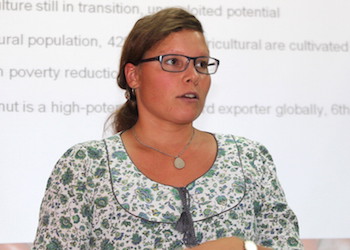Professor Hans Wiesmeth from Dresden University of Technology (TU Dresden) visit ISET last Thursday to present one of his recent papers “The Environmental Kuznets Curve”, co-authored with Shlomo Weber from New Economic School.
Professor Wiesmeth talked about climate change (especially global warming) in the world and environmental problems caused by carbon dioxide levels in the air, which is now at its highest levels in history. As GDP per capita is increasing in the country after some point level of carbon dioxide in that country decreases but generally in the world total amount is increasing year after year, as many countries are still on developing stage when alongside process of development, level of carbon dioxide in the air is increasing. Since our environment is a public good, he outlined the role of cooperation within countries while dealing these issues.
On Monday, 8th of June, Zurab Abramishvili from the CERGE-EI (Center for Economic Research and Graduate Education - Economics Institute) presented his research proposal titled “The Principal Principle: How an Immediate and Random Replacement of School Principals Illuminates Their Value Added; A Case of Education Policy in Georgia”. Mr. Abramishvili is ISET graduate 2010, currently he is doing postdoctoral work at ISET.
He started the presentation with a short overview of the reforms which the government of Georgia implemented in the education system. After he reviewed all chronologically ordered reforms from 2005 to 2007, he presented “school principal elections” in more details and stressed that this project aims to investigate the effects of this unique education policy on the learning outcomes of public school students in Georgia.
On Friday, June 5th ISET hosted Loredana Sorg, Mercator Fellow of International Affairs, who gave a presentation titled "The Georgian Hazelnut Value Chain and the Potential of Cooperatives". The objective of the study was to understand how and at which level value is added, to identify critical elements for a competitive hazelnut production in Georgia and to reflect the potential of cooperatives for the development of the value chain and in particular for organic fair-trade hazelnuts.
According to the study Georgian hazelnut sector has gained both national and international attention over the last years. Different private, public and non-governmental actors have started initiatives to upgrade the Georgian hazelnut value chain for export or development goals. This talk summarized the particularities of the Georgian hazelnut value chain and findings from discussions with ETH students at a workshop at FAO in April, 2015.













